Sections
Brand salesStore cardProduct CardBasket AnalysisQuadrant analysisProducers analysisPlanogram EfficiencyLost SalesSales ChangeCategory managersSuppliers salesMarkers comparisonCategory CardProducts salesStores salesCategories salesStock MonitoringMainUnsaleable productsPrediction of OoS24-Hour AnalysisProducts movementEffectiveness of сashiersProducts for adjustmentPOS-terminal TrafficSales PlansPromotion AnalysisNew SKUEffectiveness of Loyalty ProgramPromo CardRFM - analysisStatistic of Loyalty ProgramCustomer Loyalty SegmentationLoyalty CardComparative DynamicsReceiptsSTORES SALES
Reports on Datawiz BI service
The "Store sales" report is designed to evaluate the performance of each store and the chain as a whole. It contains two tabs: Report and Sales Structure.
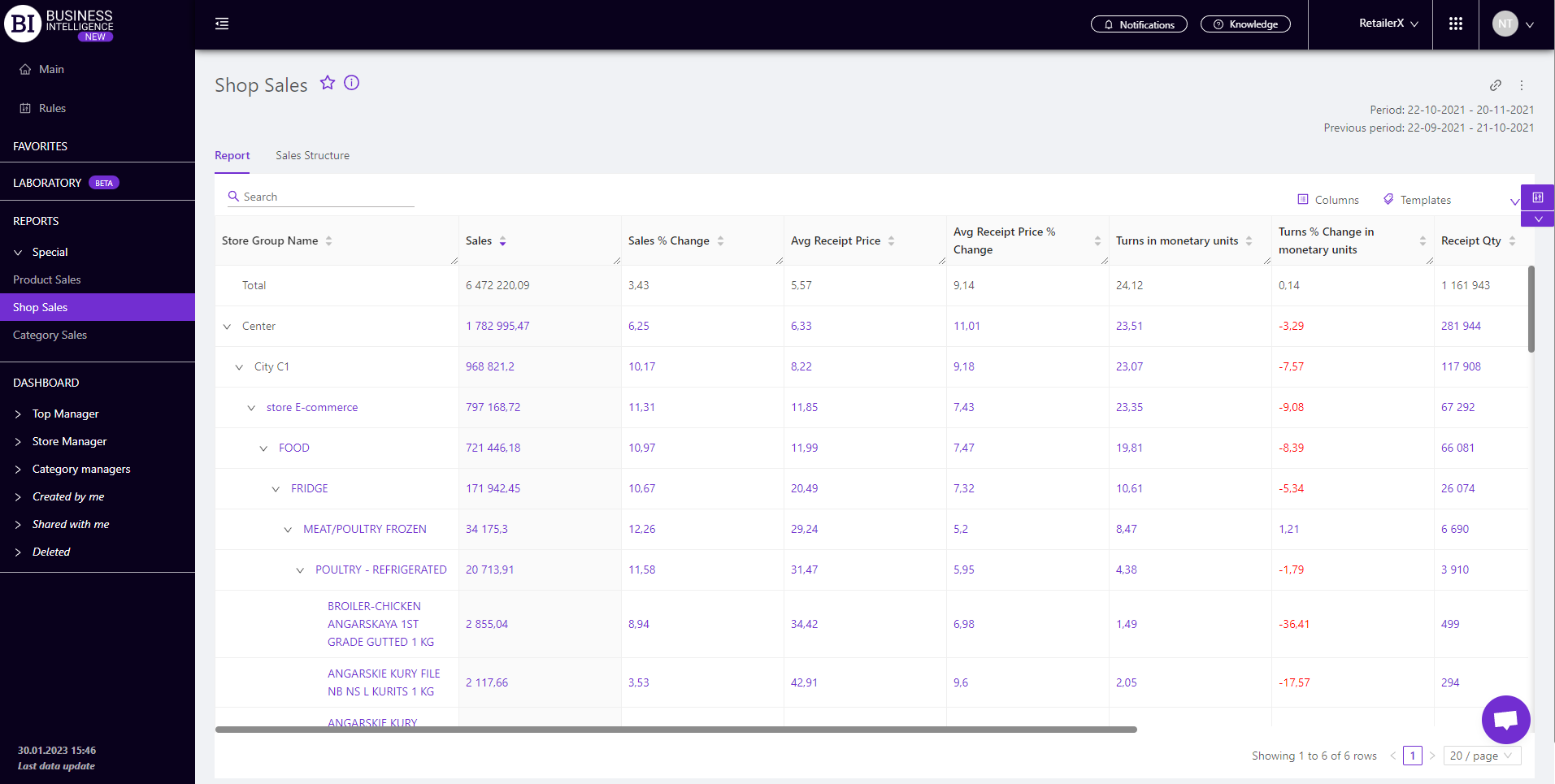
Report
The "Report" tab shows the main metrics of store and chain sales. Its functionality allows to:
- view the necessary data for two periods: "Selected" and "Previous", comparing them with each other;
- analyze data at different levels, going down from the highest (stores) to the lowest (SKU). If the stores are divided into regions, the analysis can be carried out in the context of regions, going down to stores, categories and products.
- track the dynamics of key metrics on visualization.
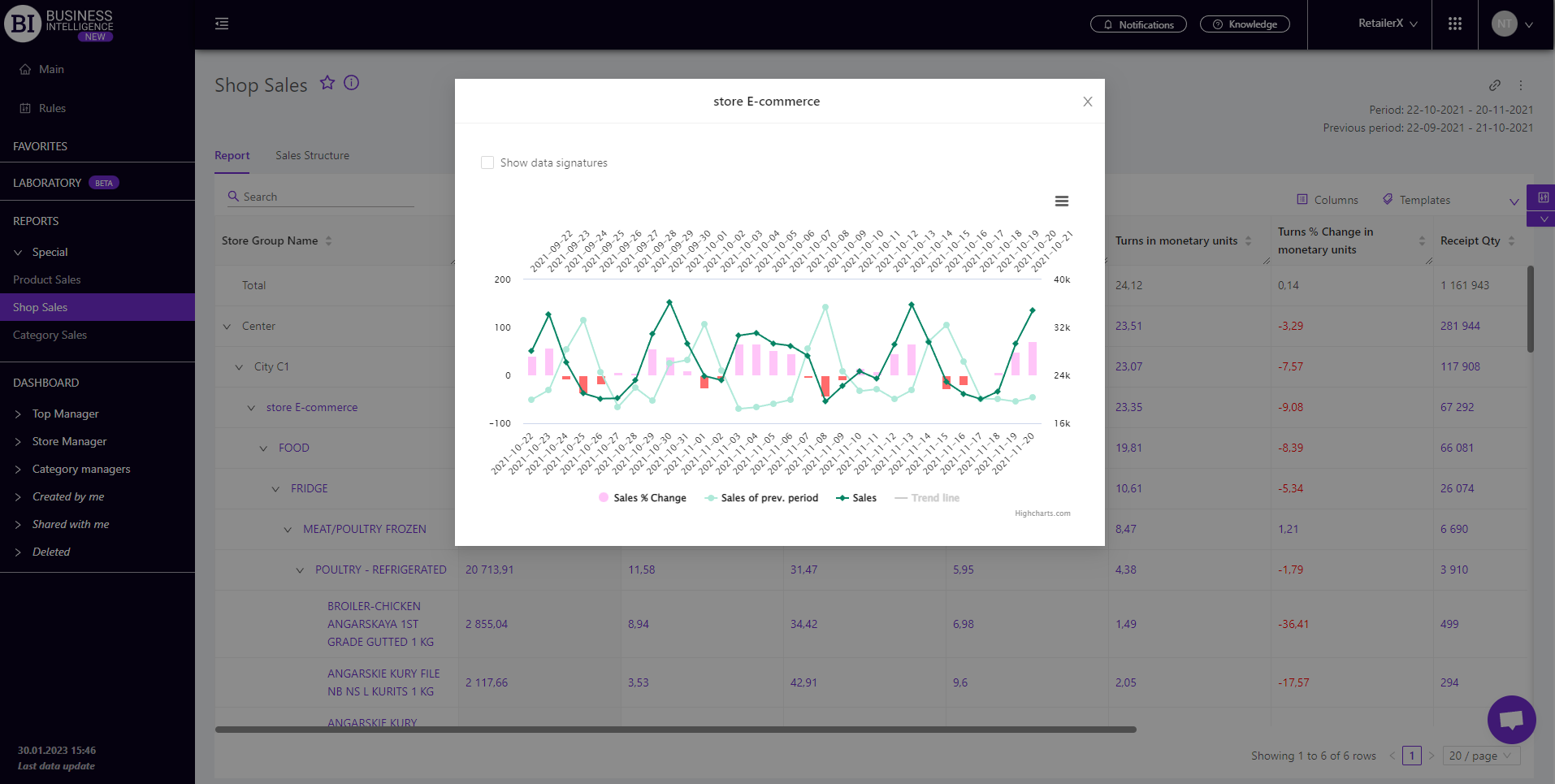
Sales structure
The "Sales Structure" tab contains two visualizations that allow to determine the share of each store in the total sales and stocks and compare them with each other:
- the upper visualization displays the structure of sales of chain stores and is built according to one of the metrics: Sales, Sales Qty, Receipts Qty, Profit.
- the bottom visualization shows the structure of the stocks and is built according to one of the metrics: Stock Qty at the end of the period, Stock Primecost of the last day.
To change the metric on the visualization you need to activate the check-box next to the required metric above the visualization.
The visualizations are interconnected. When you hover over a store name in one of the visualizations pop-ups appear on both of them with percentages and sales qty or store stocks.
Using this information you can bring the balance of sales and stocks to the optimal level.
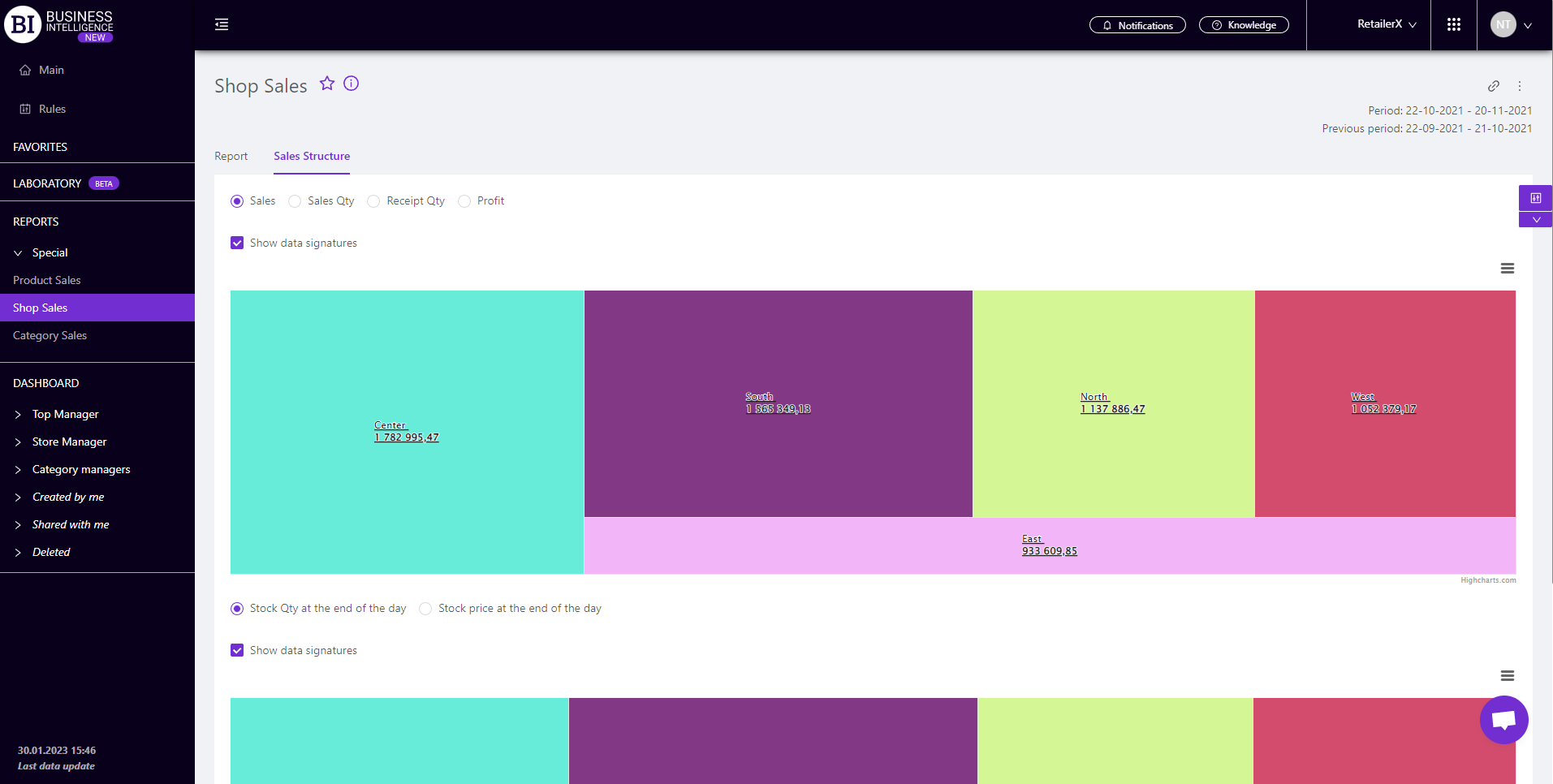
Advice! If stores have insignificant shares in sales, pay attention to their shares in the stocks. They don't have to be big. Otherwise, it will indicate a "slow" range of products in stores.
If stores are divided into regions, then visualizations can be expanded from groups to stores. To do this, just click on the desired region (group of stores). After that both visualizations fall into this group and show the structure of sales/stocks for its' stores.
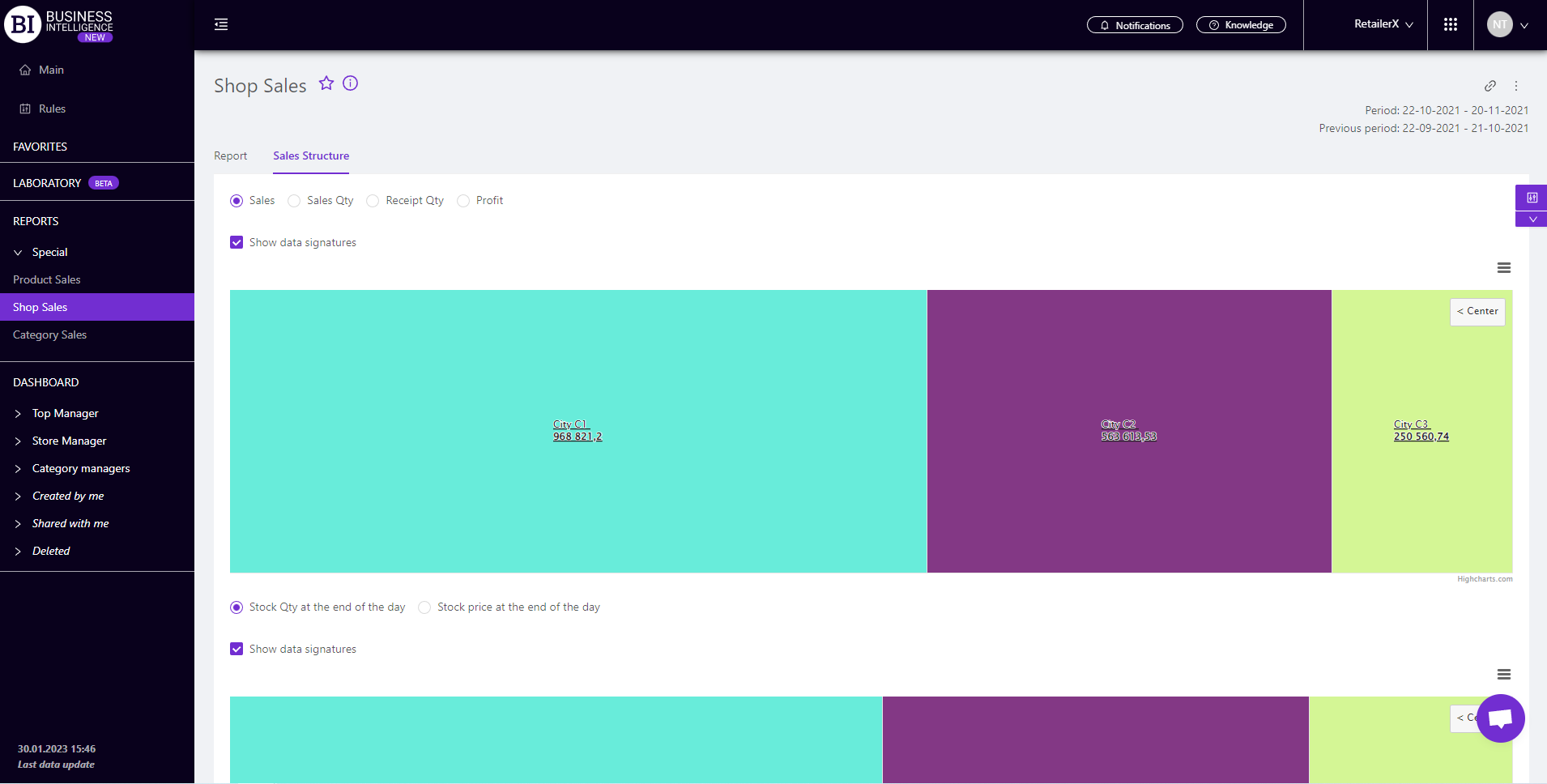
Store card
When you click on the name of the store in the report table, the "Store card" opens which shows the basic information for the selected period.
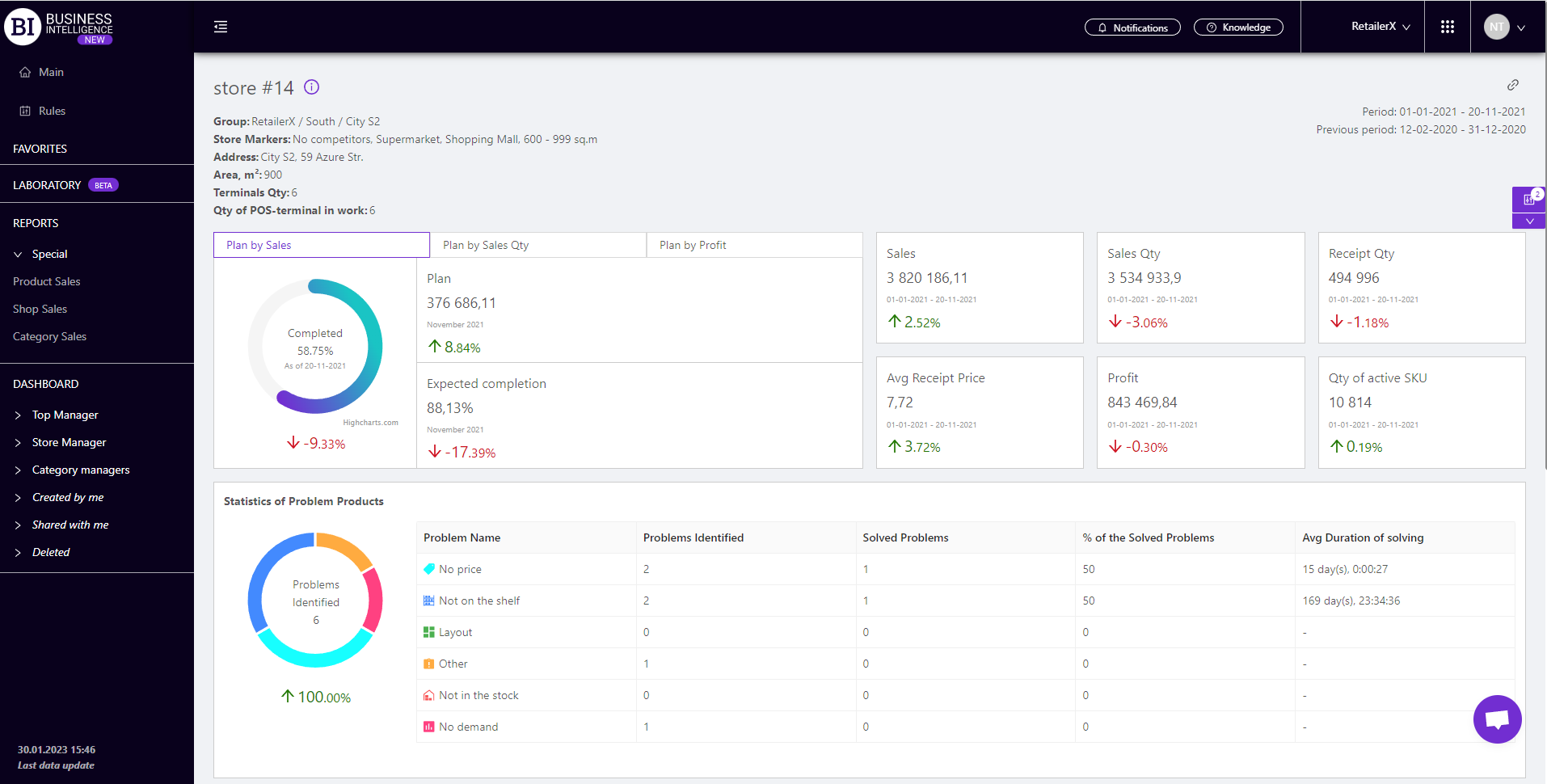
Metrics
The "Columns" button allows to select the necessary metrics for generating a report. All metrics are divided into subgroups:
Sales
- Sales
- Sales Change
- Sales Change, %
- % of total Sales
- Avg sales
- Avg Sales Change
- Avg Sales Change, %
- Promoted product Sales
- Change of promo products Sales
- Change of promo products Sales, %
- % of Sales of Promo products
- Sales of LP
- LP Sales Change
- LP Sales Change, %
- LP Sales % of total
Sales Qty
- Sales Qty
- Sales Qty Change
- Sales Qty Change, %
- % of total Sales Qty
- Avg Sales Qty
- Avg Sales Qty Change
- Avg Sales Qty Change, %
- Sales Qty of Promo products
- Sales Qty of Promo products Change
- Sales Qty of Promo products Change, %
- % of Sales Qty of Promo products
- Sales Qty of LP
- Sales Qty of LP Change
- Sales Qty of LP Change, %
- Sales Qty of LP % of total
- Coefficient of variation
Receipt Qty
- Receipt Qty
- Receipt Qty Change
- Receipt Qty Change, %
- % of total Receipts Qty
- Penetration rate, %
- Penetration Change, %
- Avg Receipt Qty
- Avg Receipt Qty Change
- Avg Receipt Qty Change, %
- Promoted Product Receipt Qty
- Change of promo product Receipt Qty
- Change of promo product Receipt Qty, %
- % of Receipt Qty with Promo products
- Penetration of receipts with promo products, %
- Penetration of receipts with promo products Change
- Receipt Qty of LP
- Receipt Qty of LP Change
- Receipt Qty of LP Change, %
- Receipt Qty of LP % of total
Avg Receipt Price
Stocks
- Stock Qty at the end of the day
- Stock Qty at the end of the day Change
- Stock Qty at the end of the day Change, %
- % of Stock Qty
- Stock Primecost at the end of the day
- Stock Primecost at the end of the day Change
- Stock Primecost at the end of the day Change, %
- % of stock primecost at the end of the day
- Avg Inventory in absolute units
- Avg Inventory in absolute units change
- Avg Inventory in absolute units change, %
- Avg Inventory in monetary units
- Avg Inventory in monetary units change
- Avg Inventory in monetary units change, %
Profit
- Profit Change
- Profit Change, %
- % of total Profit
- Avg Profit
- Avg Profit Change
- Avg Profit Change, %
- Profit of Promo products
- Profit of Promo products Change
- Profit of Promo products Change, %
- % of Profit of Promo products
- Profit of LP
- Profit of LP Change
- Profit of LP Change, %
- Profit of LP % of total
Price
Primecost of sales
- Primecost of sales
- Primecost of sales Change
- Primecost of sales Change, %
- % of Primecost of sales
- % of Primecost of sales Change
- Avg Primecost of sales
- Avg Primecost of Sales Change
- Avg Primecost of Sales Change, %
Finance metrics
- Markup, %
- Markup % Change
- Margin %
- Margin % Change
- GMROI, %
- GMROI Change
- Postponement in days
- Postponement in days Change
- Postponement in days Change, %
- Product Profitability %
- % Change of Products Profitability
- VAT
- VAT Change
- VAT Change, %
- Excise
- Excise Change
- Excise Change, %
- Financial cycle
- Finance accumulation
- Cost of capital
Discounts
- Discount amount
- Discounts amount Change
- Discounts amount Change, %
- Discount, %
- Discount Change, %
- Discounts amount of promo products
- Discounts amount of promo products Change
- Discounts amount of promo products Change, %
Turns
Supplier
- Bonuses
- Change of bonuses
- Change of bonuses, %
- % of bonuses from Sales
- Refund Qty to suppliers
- Refund Qty to suppliers Change
- Refund Qty to suppliers Change, %
- Refund Price to suppliers
- Refund Price Change to suppliers
- Refund Price Change to suppliers, %
- % of Refund Qty to suppliers
- % of Refund Qty to suppliers Change
- Refund Primecost to suppliers
- Refund Primecost Change to suppliers
- Refund Primecost Change to suppliers, %
- % of Refund Primecost to suppliers
- % of Refund Primecost to suppliers Change
- Refund documents Qty
- Refund documents Qty Change
Assortment activity
Order/Delivery
- Ordered Product Qty
- Change of Ordered Product Qty
- Change of Ordered Product Qty, %
- % of Ordered Product Qty
- Ordered Products Primecost
- Change of Ordered Products primecost
- Change of Ordered Products primecost, %
- % of Ordered Products Primecost
- Received Products Qty
- Change of Received Products Qty
- Change of Received Products Qty, %
- % of Received Products Qty
- Received Products Primecost
- Change of Received Products Primecost
- Change of Received Products Primecost, %
- % of Received Products Primecost
Posting
- Posting in absolute units Change
- Posting in absolute units Change, %
- % of Posting in absolute units
- Posting in monetary units
- Posting in monetary units Change
- Posting in monetary units Change, %
- % of Posting in monetary units
Relocation
- Relocation to store in absolute units
- Relocation to store in absolute units Change
- Relocation to store in absolute units Change, %
- Relocation to store in monetary units
- Relocation to store in monetary units Change
- Relocation to store in monetary units Change, %
- Relocation from store in absolute units
- Relocation from store in absolute units Change
- Relocation from store in absolute units Change, %
- Relocation from store in monetary units
- Relocation from store in monetary units Change
- Relocation from store in monetary units Change, %
Write-offs
- Write-offs in absolute units
- Write-offs in absolute units Change
- Write-offs in absolute units Change, %
- % of Write-offs in absolute units
- % of Write-offs of Sales Qty
- Write-offs in monetary units
- Write-offs in monetary units Change
- Write-offs in monetary units Change, %
- % of Write-offs in monetary units
- % of Write-offs of Sales
Refunds
- Refund Qty
- Refund Qty Change
- Refund Qty Change, %
- Share of returns by sales Qty, %
- Refund price
- Refund price Change
- Refund price Change, %
- Receipts Qty of refunds
- Receipts Qty of refunds Change
- Receipts Qty of refunds Change, %
Note! Access to viewing metrics according to the user's role is determined by the administrator. To expand access, contact your administrator.
Metrics highlighted in purple or red are clickable. Clicking on them opens a window with a graph of the dynamics of the selected metric.
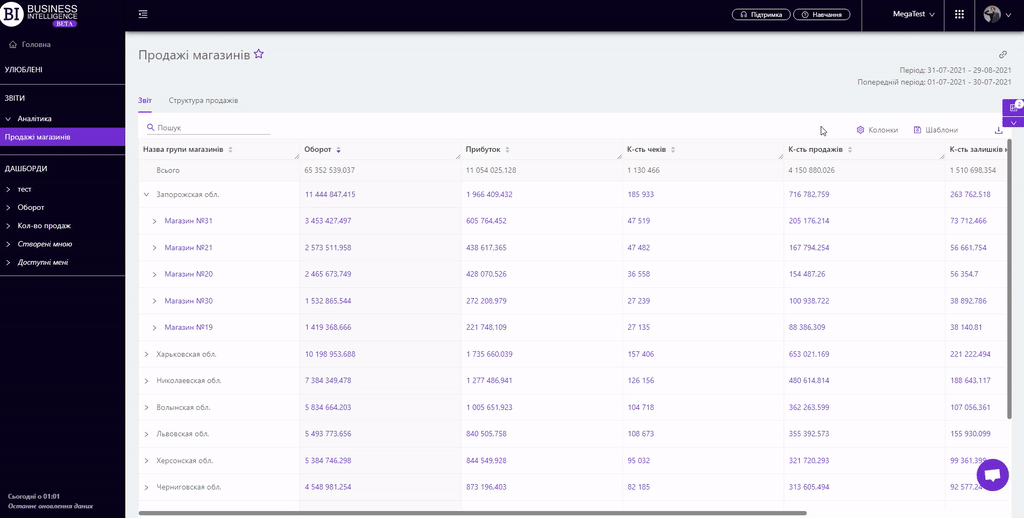
Advice! If you want to compare the metric for the selected and the previous period, you need to click on the desired clickable metric for the previous period. The graph will display curves for two periods: the selected one and the previous one.
"Templates" button - saves the configured report columns as a template.
On the right above the table a context menu is opened where the user can select the following actions:
- "Lock the total row" - fixes the "Total" row in the top row of the table.
- "Save XLS" - saves table data to an xls-file.
To quickly find the stores you need, just enter the first letters/symbols of the store name in the search field. The search works automatically, leaving all found matches in the table.
To reset the search results,you must click on the cross in the search field.
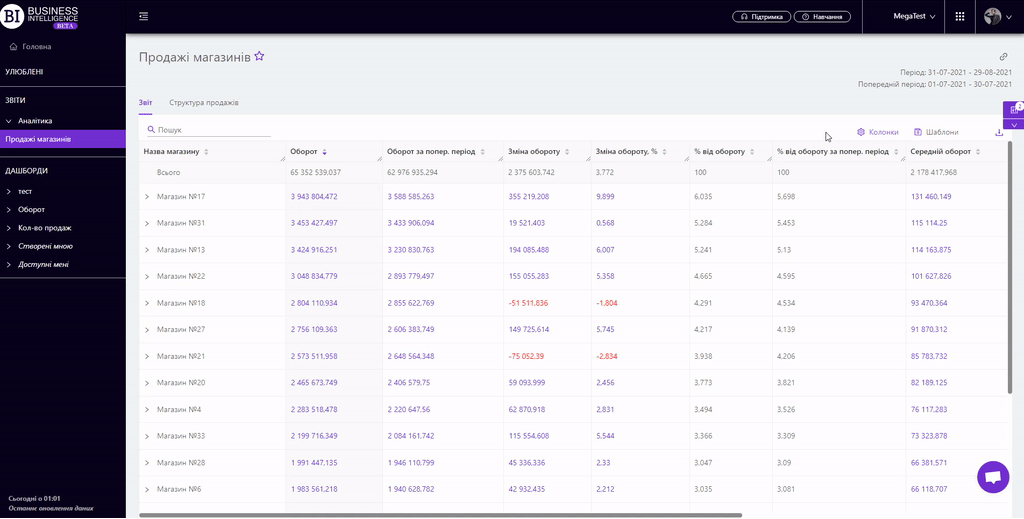
Filters
The selection of filters makes it possible to carry out the analysis within the specified conditions.
The Filters button is located on the right side above the report. Clicking on it opens a modal window with the following filters:
- Period
- Previous period
- Stores
- Categories
- Products
- Day of the week
- Interval
- Assortment types
- Write-off types
- Product markers
- Receipt markers
- Types of clients LP
- Bonus types
- Like for like
